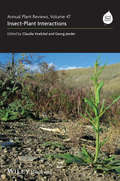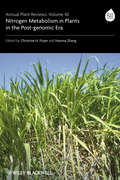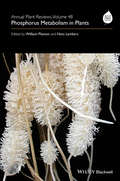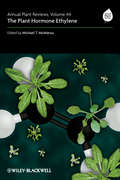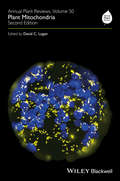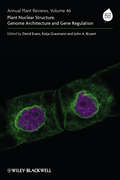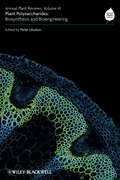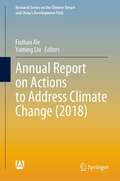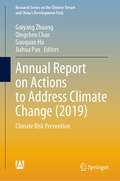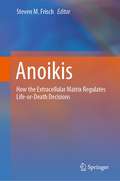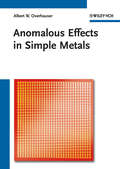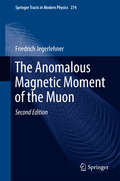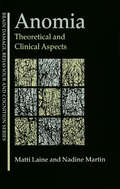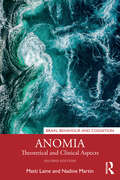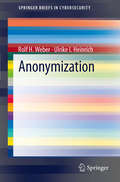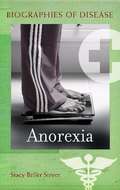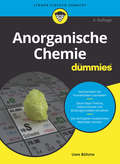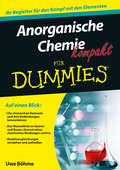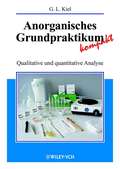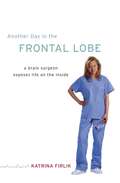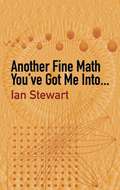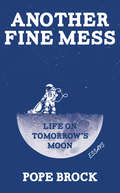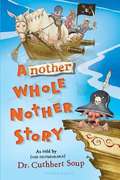- Table View
- List View
Annual Plant Reviews, Insect-Plant Interactions (Annual Plant Reviews)
by Claudia Voelckel Georg JanderThis latest volume in Wiley Blackwell’s prestigious Annual Plant Reviews brings together articles that describe the biochemical, genetic, and ecological aspects of plant interactions with insect herbivores.. The biochemistry section of this outstanding volume includes reviews highlighting significant findings in the area of plant signalling cascades, recognition of herbivore-associated molecular patterns, sequestration of plant defensive metabolites and perception of plant semiochemicals by insects. Chapters in the genetics section are focused on genetic mapping of herbivore resistance traits and the analysis of transcriptional responses in both plants and insects. The ecology section includes chapters that describe plant-insect interactions at a higher level, including multitrophic interactions, investigations of the cost-benefit paradigm and the altitudinal niche-breadth hypothesis, and a re-evaluation of co-evolution in the light of recent molecular research. Written by many of the world’s leading researchers in these subjects, and edited by Claudia Voelckel and Georg Jander, this volume is designed for students and researchers with some background in plant molecular biology or ecology, who would like to learn more about recent advances or obtain a more in-depth understanding of this field. This volume will also be of great use and interest to a wide range of plant scientists and entomologists and is an essential purchase for universities and research establishments where biological sciences are studied and taught. To view details of volumes in Annual Plant Reviews, visit: www.wiley.com/go/apr Also available from Wiley: Plant Defense Dale Walters 9781405175890 Herbicides and Plant Physiology, 2nd Edn Andrew Cobb & John Reade 9781405129350
Annual Plant Reviews, Nitrogen Metabolism in Plants in the Post-genomic Era (Annual Plant Reviews #60)
by Christine H. Foyer Hanma ZhangThe field of plant nitrogen metabolism continues to be a compelling focus for basic research activities because there is a strong demand for immediate solutions, particularly in key areas, such as improving plant nitrogen use efficiency, which are crucial to future agricultural sustainability and the future economic success of agriculture. The 13 reviews which comprise this excellent and carefully edited new volume bring together the expertise and enthusiasm of an international team of leading researchers. Topics covered include nitrogen sensing and signalling, uptake and membrane systems, nitric oxide, primary nitrogen assimilation and C/N balance and interactions, and regulation of root and plant architecture. Together, these reviews provide an insight into how plants sense, uptake and assimilate nitrogen into the organic compounds required for growth, co-ordinate nitrogen and carbon metabolism and regulate growth and development according to nitrogen availability. The transcription factors that act to integrate environmental nutrient (nitrogen) signals to co-ordinate primary and secondary metabolism are discussed, together with new concepts of cross-talk, transport and signalling, and how such molecular networks influence nitrogen and carbon cycling processes in the environment. Annual Plant Reviews, Volume 42: Nitrogen Metabolism in Plants in the Post-genomic Era is an essential purchase for advanced students, researchers and professionals in plant sciences, biochemistry, physiology, molecular biology, genetics and agricultural sciences, working in the academic and industrial sectors. Libraries in all universities and research establishments where these subjects are studied and taught will need copies of this excellent volume on their shelves.
Annual Plant Reviews, Phosphorus Metabolism in Plants
by Hans Lambers William Plaxtonal P uptake and metabolism, this book provides insights as to how plants sense, acquire, recycle, scavenge, and use P, particularly under the naturally-occurring condition of soluble inorganic phosphate deficiency that characterizes the vast majority of unfertilized soils, world-wide. It gives the reader a full appreciation of the diverse information concerning plant P-starvation responses, as well as the crucial role that plant-microbe interactions play in plant P-acquisition.Annual Plant Reviews, Volume 48: Phosphorus Metabolism in Plants is an important resource for plant geneticists, biochemists, and physiologists, as well as horticultural and environmental researchers and advanced students of plant science and university lecturers in related disciplines. It is an essential addition to the shelves of university and research institute libraries and agricultural and ecological institutions teaching and researching plant science.
Annual Plant Reviews, The Plant Hormone Ethylene (Annual Plant Reviews #65)
by Michael T. McManusThe plant hormone ethylene is one of the most important, being one of the first chemicals to be determined as a naturally-occurring growth regulator and influencer of plant development. It was also the first hormone for which significant evidence was found for the presence of receptors. This important new volume in Annual Plant Reviews is broadly divided into three parts. The first part covers the biosynthesis of ethylene and includes chapters on S-adenosylmethionine and the formation and fate of ACC in plant cells. The second part of the volume covers ethylene signaling, including the perception of ethylene by plant cells, CTR proteins, MAP kinases and EIN2 / EIN3. The final part covers the control by ethylene of cell function and development, including seed development, germination, plant growth, cell separation, fruit ripening, senescent processes, and plant-pathogen interactions. The Plant Hormone Ethylene is an extremely valuable addition to Wiley-Blackwell's Annual Plant Reviews. With contributions from many of the world's leading researchers in ethylene, and edited by Professor Michael McManus of Massey University, this volume will be of great use and interest to a wide range of plant scientists, biochemists and chemists. All universities and research establishments where plant sciences, biochemistry, chemistry, life sciences and agriculture are studied and taught should have access to this important volume.
Annual Plant Reviews, Plant Mitochondria
by David C. LoganThis long-awaited second edition covers the major changes that have occurred in the field over the last decade Completely revised with the most up-to-date research and including brand new chapters, Annual Plant Reviews, Volume 50: Plant Mitochondria, 2nd Edition presents the multifaceted roles of mitochondria in plants. The book starts with a short history of plant mitochondrial research; discusses how coevolution shaped plant mitochondrial gene expression; explains control of number, shape, size, and motility of mitochondria; delves into stress responses and roles in stress alleviation in mitochondrial biochemistry; covers the damage repair pathway of the Calvin-Benson cycle; and more. Containing sections written by many of the world’s leading researchers in this area, this book brings together and reviews for the first time many recent advances. It offers chapters on: Bioblasts, Cytomikrosomen & Chondriosomes; The Crosstalk Between Genomes; The Dynamic Chondriome; Metal Homeostasis in Plant Mitochondria; RNA Metabolism and Transcript Regulation; Mitochondrial Regulation and Signalling in the Photosynthetic Cell; Mitochondrial Biochemistry; Ecophysiology of Plant Respiration; Photorespiration; and Mitochondria and Cell Death. Annual Plant Reviews, Volume 50: Plant Mitochondria, 2nd Edition is an extremely important and timely book that will be of great use and interest to plant scientists, cell and molecular biologists, and biochemists.
Annual Plant Reviews, Plant Nuclear Structure, Genome Architecture and Gene Regulation (Annual Plant Reviews)
by David E. Evans Katja Graumann John A. BryantThis timely volume brings together expert reviews of the recent significant advances in our knowledge and understanding of the organisation of the higher plant nucleus, and in particular in the relationship between nuclear organisation and the regulation of gene expression. Rapid progress has been made in a number of key areas over the last five years, including description and characterization of proteins of the nuclear envelope and nuclear pore complex, novel insights into nucleoskeletal structures, as well as developments related to chromatin organization, function and gene expression. These advances open the way for new research into areas such as stress tolerance, plant-pathogen interactions and ultimately crop improvement and food security. Continued research into plant nuclear structure, genome architecture and gene regulation also enriches our understanding of the origin and evolution of the nucleus and its envelope. Edited by world-class researchers in plant cell biology, and comprising contributions from internationally-renowned academics, this latest volume in the prestigious Annual Plant Reviews series brings together a wealth of knowledge in the burgeoning field of plant nuclear structure and genetics. Annual Plant Reviews, Volume 46: Plant Nuclear Structure, Genome Architecture and Gene Regulation is a vital resource for advanced students, researchers and professionals in plant science and related disciplines. Libraries in all research establishments where plant science, biochemistry, molecular biology, genetics and genomics and agricultural science are taught and studied will find this excellent volume an essential addition to their shelf.
Annual Plant Reviews, Plant Polysaccharides: Biosynthesis and Bioengineering (Annual Plant Reviews Ser. #51)
by Peter UlvskovPlant Polysaccharides, an exceptional new volume in Wiley-Blackwell’s successful Annual Plant Reviews series, covers the polysaccharides and proteins that form the fundamental architecture of the plant cell wall, and the genes that encode the cellular machinery that synthesizes them. The volume focuses on the evolution of the many families of genes whose products are required to make a particular kind of polysaccharide, bringing attention to the specific biochemical properties of the proteins to the level of kinds of sugar linkages they make. Beautifully illustrated in full colour throughout, this exceptional new volume provides cutting edge up-to-date information on such important topics as cell wall biology, composition and biosynthesis, glycosyltransferases, hydroxyproline-rich glycoproteins, enzymatic modification of plant cell wall polysaccharides, glycan engineering in transgenic plants, and polysaccharide nanobiotechnology. Drawing together some of the world’s leading experts in these areas, the editor, Peter Ulvskov, has provided a landmark volume that is essential reading for plant and crop scientists, biochemists, molecular biologists and geneticists. All libraries in universities and research establishments where plant sciences, agriculture, biological, biochemical and molecular sciences are studied and taught should have copies of this important volume.
Annual Report on Actions to Address Climate Change (Research Series on the Chinese Dream and China’s Development Path)
by Fuzhan Xie Yaming LiuThis book focuses on China’s efforts to address climate change on both the strategic and practical levels since the Katowice Climate Change Conference. Featured articles provide readers with both an overview and detailed discussions of topics such as assessment of low-carbon city development, building climate resilience, global climate governance, just transition, climate finance, and others. All the contributors are leading experts in the field from Research Institute for Eco-civilization (formerly Institute of Urban and Environmental Studies), Chinese Academy of Social Sciences, and China Meteorological Administration.
Annual Report on Actions to Address Climate Change: Climate Risk Prevention (Research Series on the Chinese Dream and China’s Development Path)
by Guiyang Zhuang Qingchen Chao Guoquan Hu Jiahua PanThis book highlights China’s theoretical advances and practical actions toward climate risk prevention in 2019. It provides both an overview and detailed discussion of specific topics, including case studies. The general report assesses the latest changes in the climate system both globally and in China, and identifies areas most susceptible to the impact of climate change. This is followed by topical reports on issues such as global climate governance, China’s strategy in climate negotiations, the carbon trade, climate insurance, domestic actions to address climate concerns, including specific solutions to local challenges and achievements made by cities in China. Written by top experts in the field from Research Institute for Eco-civilization of Chinese Academy of Social Sciences and National Climate Center of China Meteorological Administration, the book aims to inform the readers on recent development and progress in climate risk prevention.
Anoikis: How the Extracellular Matrix Regulates Life-or-Death Decisions
by Steven M. FrischAnoikis is defined broadly as apoptosis that is inhibited by appropriate cell-matrix interactions. Normal and tumor cells vary widely in their sensitivity to anoikis, but, in general, metastatic tumor cells are inevitably anoikis-resistant. In particular, tumor cells that possess a cancer stem cell or mesenchymal phenotype, arising from the oncogenic Epithelial-Mesenchymal Transition (EMT), are transcriptionally re-programmed to resist anoikis. While the anoikis response occurs through the mitochondrial pathway typically found in other apoptotic responses (e.g., DNA damage, death receptors, oxidative stress), the regulation of anoikis by cell-matrix signalling is unique and only partially characterized. The uniqueness of anoikis is: a. regulation by integrins, non-integrin matrix receptors, and the signaling complexes associated with them; b. regulation by metabolic changes occurring in response to attachment/detachment; c. regulation by oncogenes and tumor suppressor genes d. regulation by tumor microenvironment; e. regulation by EMT.
Anomalous Effects in Simple Metals
by Albert OverhauserUsing potassium as an example, this work presents a unique approach to the anomalous effects in metals, resulting in knowledge that can be applied to similar materials. Most theoretical predictions on the electric, magnetic, optical, and thermal properties of a simple metal do - surprisingly - not agree with experimental behavior found in alkali metals. The purpose of this volume is to document the many phenomena that have violated expectations. It collects in one place the research by Albert Overhauser, one of the pioneers of the field. His and his collaborators work has led to a unified synthesis of alkali metal peculiarities. The unique collection of 65 reprint papers, commented where necessary to explain the context and perspective, is preceded by a thorough and well paced introduction. The book is meant to advanced solid state physics and science historians. It might also serve as additional reading in advanced solid state physics courses. With a foreword by Mildred and Gene Dresselhaus
The Anomalous Magnetic Moment of the Muon
by Friedrich JegerlehnerThis book reviews the present state of knowledge of the anomalous magnetic moment a=(g-2)/2 of the muon. The muon anomalous magnetic moment is one of the most precisely measured quantities in elementary particle physics and provides one of the most stringent tests of relativistic quantum field theory as a fundamental theoretical framework. It allows for an extremely precise check of the standard model of elementary particles and of its limitations.
Anomalous Relaxation in Colloidal Systems (Springer Theses)
by Avinash KumarThe thesis presents a systematic study of the Mpemba effect in a colloidal system with a micron-sized particle diffusing in a water bath. While the Mpemba effect, where a system’s thermal relaxation time is a non-monotonic function of the initial temperature, has been observed in water since Aristotle’s era, the underlying mechanism of the effect is still unknown. Recent studies indicate that the effect is not limited to water and has been studied both experimentally and numerically in a wide variety of systems. By carefully designing a double-well potential using feedback-based optical tweezers, the author demonstrates that an initially hot system can sometimes cool faster than an initially warm system. The author also presents the first observation in any system of another counterintuitive effect—the inverse Mpemba effect—where the colder of the two samples reaches the thermal equilibrium at a hot temperature first. The results for both the observations agree with theoretical predictions based on the Fokker-Planck equation. The experiments reveal that, for carefully chosen conditions, a strong version of both of the effects are observed where a system can relax to the bath temperature exponentially faster than under typical conditions.
Anomia: Theoretical and Clinical Aspects (Brain, Behaviour and Cognition)
by Matti Laine Nadine MartinNaming is a fundamental aspect of language. Word-finding deficit, anomia, is the most common symptom of language dysfunction occurring after brain damage. Besides its practical importance, anomia gives a fascinating view on the inner workings of language in the brain. There has been significant progress in the study of anomia in recent years, including advances in neuroimaging research and in psycholinguistic modelling. Written by two internationally known researchers in the field, this book provides a broad, integrated overview of current research on anomia. Beginning with an overview of psycholinguistic research on normal word retrieval as well as the influential cognitive models of naming, the book goes on to review the major forms of anomia. Neuroanatomical aspects, clinical assessment, and therapeutic approaches are reviewed and evaluated. Anomia: Theoretical and Clinical Aspects gives a thorough and up-to-date examination of the research and treatment of naming disorders in neurological patients. It covers both theory and practice and provides invaluable reading for researchers and practitioners in speech and language disorders, neuropsychology and neurology, as well for advanced undergraduate students and graduate students in the field.
Anomia: Theoretical and Clinical Aspects (Brain, Behaviour and Cognition)
by Matti Laine Nadine MartinThis important book provides a broad, integrated overview of current research on word-finding deficit, anomia, the most common symptom of language dysfunction occurring after brain damage. Besides its clinical importance, anomia gives a fascinating view on the inner workings of language in the brain. Written by two internationally known researchers in the field, the book begins with an overview of psycholinguistic research on normal word retrieval as well as the influential cognitive models of naming and goes on to review the major forms of anomia. Neuroanatomical aspects, clinical assessment and therapeutic approaches are reviewed and evaluated. This edition has been fully updated to include coverage of advances in cognitive modeling of lexical retrieval disorders, structural and functional neuroimaging findings on the neural basis of naming and anomia, anomia diagnostics and new approaches to the challenging task of anomia therapy. Covering both theory and practice, this book provides invaluable reading for researchers and practitioners in speech and language disorders, neuropsychology and neurology, as well as for advanced undergraduate students and graduate students in the field.
Anonymization (SpringerBriefs in Cybersecurity)
by Rolf H. Weber Ulrike I. HeinrichWithin the last decade, the Internet has developed as a phenomenon encompassing social, cultural, economic and legal facets. It has become common practice to use the Internet for both the retrieval and provision of information, with the result that the Internet has become a valuable tool in everyday life. Many Internet participants are unaware that they leave data tracks on every website they pass; surfing on the World Wide Web is far from being an anonymous activity of no consequence. In recent years a number of networking techniques have been initiated in order to accommodate the netizen's wish for anonymous communication and the protection of their privacy in the online world. Anonymization explores the legal framework developed to help protect netizens' privacy and their wish for anonymous communication over the Internet. It debates the value in helping to protect anonymity over a network which sees an increasing number of cybercrimes, and explores governmental interventions into anonymity requests, and whether requests should only be legal if a sufficiently legitimized public interest is given.
Anorexia (Biographies of Disease)
by Stacy Beller StryerThis reference for high school and up examines the history and issues of anorexia nervosa, with special focus on sociocultural and economic changes over the past century that have contributed to anorexia. Coverage includes theories about causes of the condition, diagnostic criteria and warning signs, stages of the illness, characteristics of those who develop it, medical complications, early and modern treatments, prevention, and future research. Chapter-opening quotes from the diary of one high school student, along with brief excerpts from books by other sufferers, give readers an understanding of what it's like to have anorexia. Other features include a timeline, a list of online information sources and support organizations, and a glossary. Stryer is a pediatrician and consultant. Annotation ©2009 Book News, Inc., Portland, OR (booknews.com)
Anorganische Chemie für Dummies (Für Dummies)
by Uwe BöhmeMetalle, Halbmetalle, Salze, Nichtmetallverbindungen ohne Kohlenstoff, Komplexe und Cluster: Mit all dem müssen Sie sich in der Anorganischen Chemie herumschlagen. Dieses Buch hilft Ihnen, den Kopf über Wasser zu halten. Sie erfahren, was Sie zu Wasser, elektropositiven Elementen und Elementen der weiteren Haupt- und Nebengruppen, Komplexverbindungen und vielem mehr wissen sollten. Abgerundet wird das Buch durch eine Einführung in die gängigen Analysemethoden. So verliert die Anorganische Chemie auch für Sie ihren Schrecken.
Anorganische Chemie kompakt für Dummies (Für Dummies)
by Uwe BöhmeSie suchen einen schnellen und leicht verständlichen Einstieg in die Anorganische Chemie? Wunderbar, dann ist dieses Buch genau das richtige für Sie! Dr. Uwe Böhme erklärt Ihnen alles Wichtige zu Atomen, Verbindungen, Reaktionsmechamismen und Co. Sie erfahren, welche Eigenschaften die Elemente des Periodensystems haben und was es mit Säuren, Basen, Redoxreaktionen und vielem mehr auf sich hat. So ist dies Ihr perfekter Nachhilfelehrer für die Tasche: freundlich, kompetent, günstig.
Anorganisches Grundpraktikum kompakt: Qualitative und quantitative Analyse
by Gertrud KielMit Erfolg durchs anorganische Grundpraktikum! Erstmals präsentiert Gertrud Kiel ihr neues, preisgekröntes und unter Fachleuten anerkanntes Konzept für das Grundpraktikum Chemie in Buchform. Komprimiert auf das Wesentliche und innovativ in der Gestaltung liegt der Schwerpunkt dieses Werkes auf der Minimierung des Chemikalienverbrauchs - denn umweltbewußtes Experimentieren im Labor will gelernt sein! Die Lernhilfen umfassen: · Einführungen vor jedem Versuch · Hinweise und Abbildungen für die Durchführung · Angaben der Gefahrstoffsymbole verbunden mit den R-und S-Sätzen, damit lästiges Nachschlagen entfällt · Hilfen für die rechnerische Überprüfung der Reaktionsbedingungen sowie begleitende Tabellen mit den benötigten Konstanten · ein Kapitel zu kristallchemischen Reaktionen mit einem einzigartigen Bildatlas · einen Anhang mit sämtlichen, fürs Praktikum benötigten Lösungen und Feststoffen Wenn das Grundpraktikum so eingängig, umweltfreundlich und anschaulich dargeboten wird, dann macht Experimentieren nicht nur Spaß, sondern ist auch erfolgreich! Vorlagen für die Versuchsprotokolle finden Sie unter http://www.wiley-vch.de/books/info/3-527-30584-X/.
Another Day in the Frontal Lobe: A Brain Surgeon Exposes Life on the Inside
by Katrina FirlikKatrina Firlik is a neurosurgeon, one of only two hundred or so women among the alpha males who dominate this high-pressure, high-prestige medical specialty. She is also a superbly gifted writer–witty, insightful, at once deeply humane and refreshingly wry. In Another Day in the Frontal Lobe, Dr. Firlik draws on this rare combination to create a neurosurgeon’s Kitchen Confidential–a unique insider’s memoir of a fascinating profession.Neurosurgeons are renowned for their big egos and aggressive self-confidence, and Dr. Firlik confirms that timidity is indeed rare in the field. “They’re the kids who never lost at musical chairs,” she writes. A brain surgeon is not only a highly trained scientist and clinician but also a mechanic who of necessity develops an intimate, hands-on familiarity with the gray matter inside our skulls. It’s the balance between cutting-edge medical technology and manual dexterity, between instinct and expertise, that Firlik finds so appealing–and so difficult to master. Firlik recounts how her background as a surgeon’s daughter with a strong stomach and a keen interest in the brain led her to this rarefied specialty, and she describes her challenging, atypical trek from medical student to fully qualified surgeon. Among Firlik’s more memorable cases: a young roofer who walked into the hospital with a three-inch-long barbed nail driven into his forehead, the result of an accident with his partner’s nail gun, and a sweet little seven-year-old boy whose untreated earache had become a raging, potentially fatal infection of the brain lining. From OR theatrics to thorny ethical questions, from the surprisingly primitive tools in a neurosurgeon’s kit to glimpses of future techniques like the “brain lift,” Firlik cracks open medicine’s most prestigious and secretive specialty. Candid, smart, clear-eyed, and unfailingly engaging, Another Day in the Frontal Lobe is a mesmerizing behind-the-scenes glimpse into a world of incredible competition and incalculable rewards.From the Hardcover edition.
Another Fine Math You've Got Me Into. . .
by Ian StewartPopulated by curious creatures whose stories unfold with jokes and puns, this mathematical wonderland of puzzles and games also imparts significant mathematical ideas. Ian Stewart, an active popularizer of mathematics, university professor, and former columnist for Scientific American's "Mathematical Games" section, has selected 16 of his columns from Pour la Science, the French edition of Scientific American, most based on a mathematical idea dressed up with oddball characters and wacky wordplay.
Another Fine Mess: Life on Tomorrow's Moon: Essays
by Pope BrockThe author of Charlatan is &“the perfect armchair cosmonaut&” for &“a very funny and provocative rumination on the big move to off-planet real estate&” (Mark Haskell Smith, author of Blown). We&’ve gotten into another fine mess, destroying the planet and all. So where will we go next? Is it time to colonize outer space? Acclaimed essayist Pope Brock takes us on a vivid satirical journal to learn just what life might look like living on tomorrow&’s moon. &“Though the reader finds herself in happy contemplation of crisping ex-lovers with lasers from a future lunar workplace, or perhaps having imperfect sex in perfect spheres of water, or simply socializing on the moon with well-adapted sociopaths, nevertheless we also get to know the fiercely earthbound heart of Pope Brock. His vision is both funny and horrifying, a Seussian galaxy of rumpus absurdity and straight-talking hard truths. By the end of it one thinks, &‘Ah, Humanity&’ but right upon that one thinks, &‘Thank goodness for Pope Brock.&’&” —Leigh Allison Wilson, author of From the Bottom Up &“Deft, funny, profound in its implications—and also a grave prediction about the mess that may soon be transferred from the Earth to the moon. A beguiling and original story by a writer whose wisdom is only matched by his wicked comic timing.&” —Sarah Braunstein, author of The Sweet Relief of Missing Children &“An inspired observer with a poet&’s heart, his investigation into our lunar future is informed, wry and sublimely readable.&”—Cathy Galvin, founder of the Word Factory, London
Another Whole Nother Story
by Cuthbert SoupIn this sequel to "A whole nother story," Ethan Cheeseman takes his children, ages eight, twelve, and fourteen, and Captain Jibby and crew, to the year 1668 to end an ancient family curse and save the children's mother, but damage to the time machine and the arrival of Mr. 5 complicate their return.
